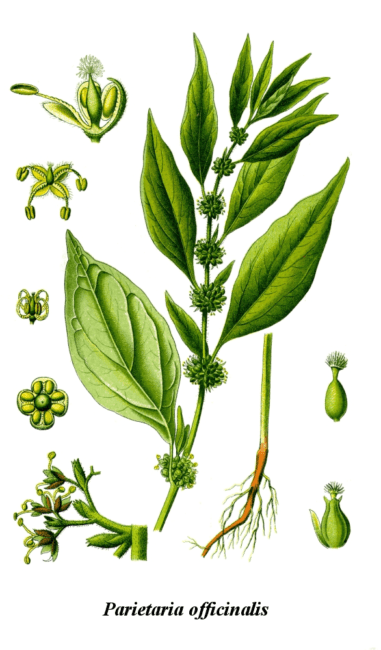Parietaria officinalis, commonly known as Upright Pellitory, is a herbaceous plant belonging to the Urticaceae family. It is native to Europe and can be found in various regions across the continent.
This perennial herb is renowned for its distinctive upright growth habit, typically reaching heights of up to 50 centimeters. Its unique botanical name, “Parietaria,” is derived from the Latin word “parietarius,” meaning “of walls,” as it often thrives in the nooks and crannies of walls and rocky areas.
The leaves of Parietaria officinalis are lance-shaped and have a slightly serrated edge, while the stem is covered with fine, short hairs. The plant blooms with inconspicuous greenish flowers that grow in clusters, and it is known for producing tiny, kidney-shaped seeds. Upright Pellitory is a versatile plant with a long history of traditional medicinal use.
Ithas been employed for its diuretic and anti-inflammatory properties and has been utilized in herbal remedies for various ailments. Additionally, the plant serves as a valuable food source for certain caterpillar species and is often considered a useful plant in traditional herbal medicine and botanical studies.
The Botanical Description of Parietaria officinalis
1. Family and Classification: Parietaria officinalis, commonly known as the upright pellitory, belongs to the Urticaceae family. It is a part of the Parietaria genus, which comprises various species of flowering plants.
2. Growth Habit: Parietaria officinalis is a low-growing, herbaceous plant characterized by its prostrate to upright growth habit. It often reaches a height of about 1 to 3 feet (30 to 90 centimeters).
3. Leaves: The leaves of Parietaria officinalis are alternate, lance-shaped, and serrated at the margins. They are typically dark green and have a slightly waxy texture, contributing to their distinctive appearance.
4. Flowers: The plant produces small, inconspicuous flowers that are green to yellowish-green in color. These flowers are arranged in clusters and lack the showy petals often associated with flowering plants.
5. Habitat: Parietaria officinalis is commonly found in waste areas, roadsides, and disturbed soils. It is known for its resilience in urban environments and can often be seen growing in cracks in pavement or walls.
The Geographic Distribution of Parietaria officinalis
1. Native Range: Parietaria officinalis is native to various regions of Europe, including Mediterranean countries such as Italy, Spain, and Greece. It thrives in the mild, Mediterranean climate of these areas.
2. Naturalized Regions: Over time, Parietaria officinalis has naturalized and spread to other parts of the world. It can be found in North America, South America, Asia, and Australia, often in areas with similar temperate climates.
3. Urban Environments: The adaptability of Parietaria officinalis to urban environments has led to its widespread presence in cities and towns worldwide. It often grows in cracks and crevices of buildings and pavement.
4. Soil Preferences: Parietaria officinalis prefers well-drained, sandy or loamy soils. It is well-suited to areas with disturbed soils, making it a common sight in areas with human activity.
The Chemical Composition of Parietaria officinalis
1. Flavonoids: Parietaria officinalis contains various flavonoids, including quercetin and kaempferol. These compounds are known for their antioxidant properties and potential health benefits.
2. Alkaloids: Some alkaloids have been identified in Parietaria officinalis. While the specific alkaloids can vary between plant samples, their presence contributes to the plant’s chemical makeup.
3. Tannins: Tannins are polyphenolic compounds found in Parietaria officinalis. They have astringent properties and are often associated with their ability to precipitate proteins.
4. Vitamins and Minerals: Parietaria officinalis may contain various vitamins and minerals, including vitamin C, calcium, and potassium. These nutrients contribute to the plant’s potential nutritional value.
5. Polysaccharides: Polysaccharides are complex carbohydrates that can be found in Parietaria officinalis. They play a role in the plant’s structural integrity and may have other physiological functions.
Understanding the botanical description, geographic distribution, and chemical composition of Parietaria officinalis provides valuable insights into this plant species.
While it may be considered a common weed in some regions, its unique characteristics and chemical components make it an intriguing subject of study for botanists and herbalists. Whether found growing in the wild or in urban environments, Parietaria officinalis has a place in the world of plants and their ecological significance.
Read Also: 6 Medicinal Health Benefits Of Sisyrinchium bellum (Blue-Eyed Grass)
The Medicinal Health Benefits Of Parietaria officinalis (Upright Pellitory)

1. Anti-Inflammatory Properties: Parietaria officinalis has been used traditionally for its anti-inflammatory properties. It may help reduce inflammation in various conditions, including skin irritations, allergies, and respiratory issues.
2. Respiratory Health: The herb is known for its potential in promoting respiratory health. It has been used to ease symptoms of respiratory conditions like asthma and bronchitis, helping to relieve coughing and congestion.
3. Antioxidant Action: Parietaria officinalis contains flavonoids, which act as antioxidants. These compounds can neutralize harmful free radicals in the body, potentially reducing oxidative stress and protecting cells from damage.
4. Diuretic Effect: The herb has diuretic properties, which means it can increase urine production. This can be beneficial for individuals with fluid retention issues or urinary tract discomfort.
5. Skin Health: Parietaria officinalis has been used topically to alleviate skin conditions, including rashes and itching. It is believed to soothe skin irritations and promote healing.
6. Gastrointestinal Relief: Some traditional uses of Parietaria officinalis involve digestive relief. It may help with symptoms like indigestion and bloating, possibly due to its anti-inflammatory properties.
The Methods of Usage to Achieve the Provided Health Benefits Of Parietaria officinalis (Upright Pellitory)
1. Herbal Infusion: To harness the medicinal benefits of Parietaria officinalis, you can prepare an herbal infusion or tea. Steep dried or fresh leaves in hot water and drink the infusion. This method is commonly used for respiratory and anti-inflammatory purposes.
2. Topical Applications: For skin issues or skin irritations, you can create a poultice or compress using crushed or macerated Parietaria officinalis leaves. Apply this directly to the affected area to promote healing and reduce itching.
3. Tinctures and Extracts: Tinctures and extracts are concentrated forms of Parietaria officinalis. These can be taken orally or used topically, depending on the desired effect.
4. Capsules and Tablets: Parietaria officinalis supplements in the form of capsules or tablets are available. These provide a convenient and controlled way to consume the herb for various health benefits.
5. Inhalation: Inhaling the vapor of a Parietaria officinalis infusion may help with respiratory issues. This can be achieved by inhaling the steam or using a vaporizer.
6. Dietary Inclusion: Some people include Parietaria officinalis in their diet by adding it to salads or incorporating it into their meals. This method allows for a consistent but mild consumption of the herb’s benefits.
The Side Effects Of Using Parietaria officinalis Medicinal Plant
1. Allergic Reactions: While Parietaria officinalis is generally considered safe, some individuals may be allergic to it. Allergic reactions can include skin rashes, itching, or respiratory discomfort. If you experience any adverse reactions, discontinue use.
2. Gastrointestinal Upset: In rare cases, the consumption of Parietaria officinalis may lead to gastrointestinal discomfort, including nausea and diarrhea. This is more likely with excessive consumption.
3. Interaction with Medications: Parietaria officinalis may interact with certain medications. If you are taking any medications, consult with a healthcare professional before using it as an herbal remedy.
4. Pregnancy and Breastfeeding: It is not recommended to use Parietaria officinalis during pregnancy or while breastfeeding, as its safety in these situations has not been thoroughly studied.
5. Kidney Disorders: Individuals with kidney disorders should use Parietaria officinalis with caution due to its diuretic properties. Excessive use may exacerbate kidney issues.
6. Dosage: Using Parietaria officinalis in moderation is essential. Excessive consumption may lead to adverse effects. It is advisable to follow recommended dosages and consult a healthcare professional for personalized guidance.
Parietaria officinalis, with its diverse health benefits, has been a part of traditional herbal medicine for generations. However, it’s important to use this herb responsibly, with an understanding of its potential side effects and interactions. If you are considering Parietaria officinalis as a part of your healthcare routine, consulting with a healthcare professional can help ensure safe and effective usage.
Read Also: 7 Medicinal Health Benefits Of Ribes divaricatum (Straggly Gooseberry)
The Scientific Research and Studies of Parietaria officinalis (Upright Pellitory)

1. Anti-Inflammatory and Antioxidant Properties: Scientific studies have investigated the anti-inflammatory and antioxidant potential of Parietaria officinalis. Research suggests that the herb’s compounds, such as flavonoids, contribute to its ability to reduce inflammation and oxidative stress.
2. Respiratory Health: Studies have explored the traditional use of Parietaria officinalis in promoting respiratory health. Research indicates that the herb may help alleviate symptoms of respiratory conditions, but more rigorous clinical trials are needed to confirm its effectiveness.
3. Diuretic Effects: The diuretic properties of Parietaria officinalis have been examined in scientific research. This effect can aid in fluid balance and urinary tract health, although further studies are required to establish optimal dosages.
4. Skin Healing: Some scientific investigations have looked into the herb’s potential for skin healing. Parietaria officinalis may have applications in dermatology, but more research is necessary to determine its precise mechanisms.
5. Gastrointestinal Benefits: Research has explored the traditional use of Parietaria officinalis for digestive relief. Preliminary findings suggest that it may help with indigestion, but comprehensive clinical trials are warranted.
6. Toxicological Studies: Scientific research has delved into the safety and potential toxicological aspects of Parietaria officinalis use. These studies aim to identify any potential risks and guide safe usage.
The Safety Precautions and Recommendations In Using Parietaria officinalis (Upright Pellitory) Medicinal Plant
1. Allergic Reactions: Individuals should be aware of potential allergic reactions. If you experience skin rashes, itching, or respiratory discomfort after using Parietaria officinalis, discontinue use immediately.
2. Dosage Regulation: It’s crucial to use Parietaria officinalis in moderation. Following recommended dosages is important to prevent adverse effects, such as gastrointestinal discomfort.
3. Medication Interactions: Parietaria officinalis may interact with certain medications. If you are taking any medications, especially for respiratory or kidney conditions, consult with a healthcare professional before using it.
4. Pregnancy and Breastfeeding: Pregnant and breastfeeding individuals should avoid using Parietaria officinalis, as its safety in these situations has not been thoroughly studied.
5. Kidney Disorders: Individuals with kidney disorders should use Parietaria officinalis with caution due to its diuretic properties. Excessive use may worsen kidney issues.
6. Consultation with Healthcare Professionals: It is advisable to seek guidance from healthcare professionals before incorporating Parietaria officinalis into your healthcare routine, especially if you have underlying health conditions.
FAQs About Parietaria officinalis (Upright Pellitory) Medicinal Plant
1. Is Parietaria officinalis safe to use?
Parietaria officinalis is generally considered safe when used in moderation and following recommended dosages. However, some individuals may be allergic to it.
2. Can Parietaria officinalis be used for respiratory issues?
The herb has been traditionally used for respiratory health, but more scientific studies are needed to confirm its effectiveness.
3. Are there any side effects of using Parietaria officinalis?
Potential side effects may include allergic reactions, gastrointestinal discomfort, and interactions with medications. It’s essential to use it with caution and under guidance.
4. Can I use Parietaria officinalis during pregnancy or while breastfeeding?
It is not recommended to use Parietaria officinalis in these situations due to a lack of comprehensive safety data.
5. How should I determine the right dosage of Parietaria officinalis?
Dosages may vary, so it’s best to consult with a healthcare professional for personalized guidance.
6. Can I find Parietaria officinalis supplements in the market?
Parietaria officinalis supplements in various forms are available. However, it’s important to choose reliable brands and adhere to recommended dosages.
Scientific research, safety precautions, and FAQs provide valuable information for individuals considering the use of Parietaria officinalis as a medicinal plant. While it has demonstrated potential health benefits, responsible and informed usage is essential. Consulting with healthcare professionals can help ensure safe and effective integration into one’s healthcare regimen.
Read Also: Guide to Proper Management of Solid Waste
